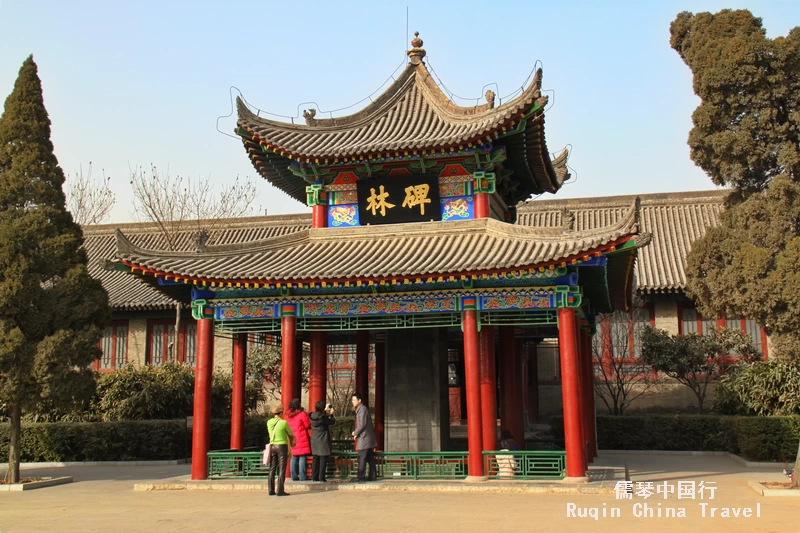If you’re a foreign tourist planning your Xi’an Tour, this guide will show you exactly how to visit Xi’an Stone Stele Museum, including practical details on tickets, opening hours, key exhibits, and cultural significance.
Xi’an, known as the ancient capital of China, is a treasure trove of historical relics. One of the most fascinating places in this historic city is the Forest of Stone Steles Museum, also referred to as the Xi’an Stone Stele Museum or Xi’an Beilin Museum (西安碑林博物馆). This museum is home to an extensive collection of stone tablets, inscriptions, and sculptures, providing a rare glimpse into ancient Chinese culture and calligraphy.
Very Important Notice from Xi’an Stele Musuem:
Dear Visitors,
Thanks to your concern and support, the Xi’an Beilin Museum expansion and renovation project has entered a crucial year. According to the project’s construction schedule, key tasks such as ancient building repairs, upgrading exhibits in the old and new museum areas, and environmental improvements will be carried out between January and December 2024. The construction will primarily affect the area north of Beilin Square in the old museum district (including Beilin Square, Exhibition Rooms 1 through 7, Xi’an Stone Carving Art Room, and the Stone Carving Art Hall). As this area no longer meets the basic conditions for visitor access, we will enforce closed construction management in the region north of Beilin Square.
The Xi’an Beilin Museum consists of two parts: Beilin and the Confucian Temple ancient architectural complex (south of Beilin Square). Starting January 10, we will implement a reduced ticket price policy. From January 14, only the Confucian Temple ancient architectural complex area will remain open to the public.
What is the Xi’an Stone Stele Museum?
The Xi’an Stone Stele Museum, also called the Stele Forest, was established in 1087 and is one of China’s most significant museums. Located in Beilin District, it houses more than 3,000 steles, some of which date back to the Han Dynasty (206 BC–220 AD) and the Tang Dynasty (618–907 AD). These steles are stone slabs engraved with Chinese characters, documenting everything from ancient laws to classical literature and calligraphy.
More than just a museum, the Xi’an Beilin Museum offers visitors a walk through China’s cultural, literary, and philosophical history. As you explore the museum, you’ll encounter ancient writings and delicate carvings. They offer deep insights into the evolution of Chinese thought.
How to Get to Beilin Museum in Xi’an
Understanding how to get to Beilin Museum in Xi’an is essential for a smooth visit. The museum is centrally located in Beilin District, which is within the city walls and close to many other attractions, including the Bell Tower and South Gate.
Address: 15 Sanxue Street, Beilin District, Xi’an 西安市碑林区三学街15号
By Subway
The most convenient way to reach the museum is by taking Subway Line 2 to Yongningmen Station (South Gate Station). From there, it’s about a 15-minute walk to the museum entrance. Signs in English are available along the way, making it easy for foreign tourists to navigate.
By Bus
Several bus routes can take you directly to the Xi’an Stone Stele Museum, including Bus No. 6, 8, and 26, which stop nearby. Buses are an affordable way to get around Xi’an and connect you to various key points in the city.
By Taxi or Rideshare
Taxis and rideshare services like DiDi are also widely available. A taxi ride from the downtown area typically costs around 10-15 RMB, depending on traffic. It’s a quick and convenient way to reach the museum if you’re staying near the city center.
Opening Hours and Ticket Prices
To plan your visit, it’s important to know the Stone Stele Museum Xi’an opening hours and ticket prices.
Maximum daily capacity: 3,000 people
Ticket Inquiry: 029-87253331
Guide Service Inquiry: 029-87213868
Museum Office: 029-87210764, 029-87282184 (Fax)
Opening Hours: The museum opens at 9:00 AM. Ticket checking stops at 5:00 PM, and the museum closes at 5:30 PM. Please bring a valid ID, such as an identity card, student ID, military ID, Hong Kong/Macau travel permit, passport, or senior citizen card, to enter the museum.
Ticket Prices: 10 RMB per person for the time being.
How to Book the Entrance Tickets
The Xi’an Beilin Museum implements a real-name ticket reservation system using ID cards. Visitors are required to make reservations in advance through the official WeChat account, the official website, or Alipay. When purchasing tickets, visitors must provide their ID card information or an electronic QR code to enter the museum.
For individuals with special credentials (such as military ID, soldier ID, or disability certificate), they must visit the ticket counter to exchange for a free ticket.
Tickets are issued based on a timed reservation system, meaning visitors must arrive during the reserved time slot. If visitor traffic is too high on the day of the visit, crowd management may be implemented, and ticket sales will stop if the maximum daily capacity is reached.
The specific steps for ticket reservation and purchase include:
- Selecting the visit date
- Adding visitor information
- Confirming the order
- Submitting payment
Tickets are available for online purchase five days in advance, with a maximum of five tickets per order. All visitors must enter accurate personal identification information. Chinese citizens must enter their ID card information, while foreign visitors must provide their passport information. Tickets are valid only on the date and time of the visit, and single entry is allowed. If an invoice is needed, it can only be issued for tickets purchased through the museum’s official ticketing channels, and visitors can request this at the ticket counter.
If you’re interested in a more in-depth experience, consider hiring a tour guide for an additional fee. The guided tours offer detailed insights into the cultural significance of each exhibit.
Best Time to Visit Stone Stele Forest in Xi’an
The best time to visit Stele Forest in Xi’an is during the spring (March to May) or autumn (September to November) months. These seasons offer comfortable temperatures, making it easier to explore not only the museum but also the surrounding attractions.
Xi’an can be hot during the summer, so visiting earlier in the day will help you avoid the afternoon heat. Winter, on the other hand, can be cold, but the museum is a great indoor activity if you’re visiting during the cooler months.
To avoid large crowds, visit on a weekday morning, as weekends and public holidays can be busy.
What to See at Xi’an Stone Stele Musuem
There’s plenty to discover when exploring the Stele Forest Museum in Xi’an. First, the museum houses over 11,000 artifacts, including 134 national treasure-level cultural relics and 535 first-class artifacts. Additionally, it proudly displays four of the famous “Six Steeds of Zhaoling”. These relics offer a glimpse into China’s rich history.
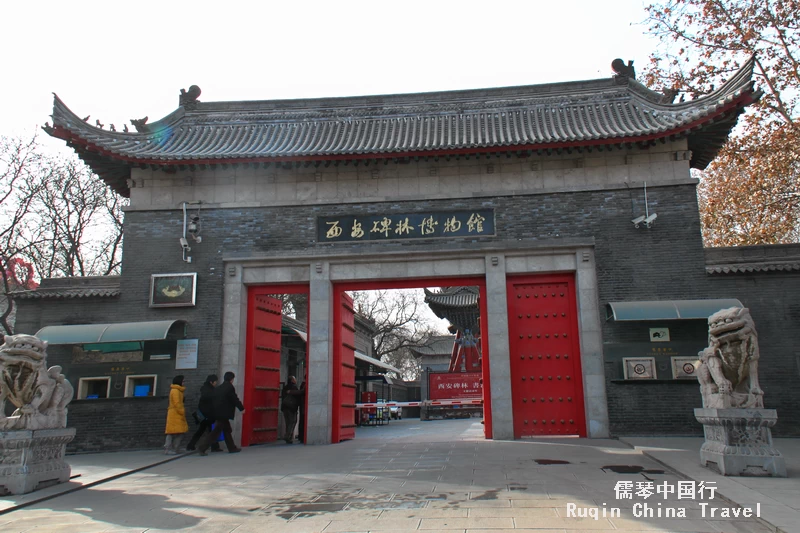
Furthermore, the museum is divided into seven exhibition rooms, each presenting different steles and stone sculptures. These rooms guide visitors through various aspects of Chinese art and history. Below are some of the must-see exhibits you should explore during your visit.
1) First Exhibition Room
The First Exhibition Room showcases the Kaicheng Stone Classics, which include 12 important classical works. These texts feature familiar titles such as the “Book of Changes” (Zhouyi), “Book of Documents” (Shangshu), “Book of Songs” (Shijing), and “Book of Rites” (Liji). Additionally, you will find “Zuo’s Commentary on the Spring and Autumn Annals” (Zuozhuan), “The Analects” (Lunyu), “Classic of Filial Piety” (Xiaojing), and “Erya”. Together, they make up a rich collection of over 600,000 characters, all engraved on 114 stone tablets.
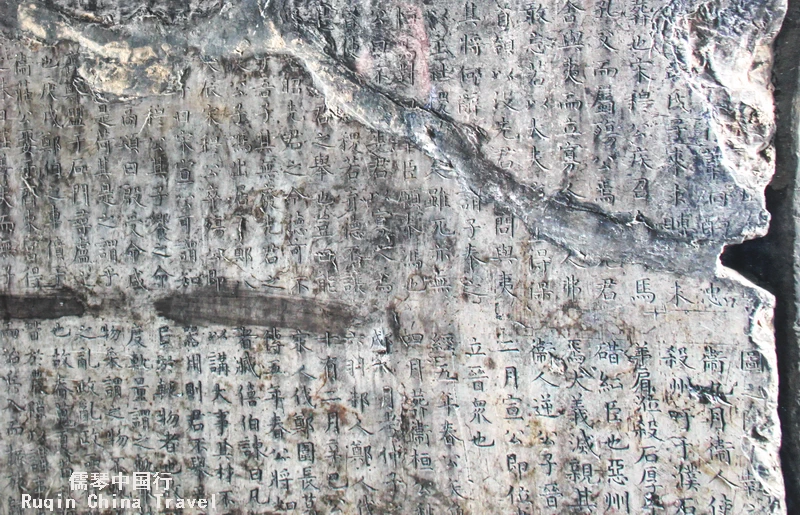
Additionally, the Mencius, carved during the Qing Dynasty, is displayed in this room. When combined with the other texts, these works are referred to as the Thirteen Classics. Notably, the Kaicheng Stone Classics remain the only complete set of stone-carved classical texts still preserved today. This makes them an invaluable piece of China’s cultural heritage.
2) Second Exhibition Room
The Second Exhibition Room focuses on famous calligraphy steles, mainly from the Tang Dynasty. First, the “Nestorian Stele” and “Monk Bukong Stele” provide valuable insights into the cultural exchanges between China and foreign nations during this period. These steles highlight the rich interactions that shaped Tang Dynasty society.
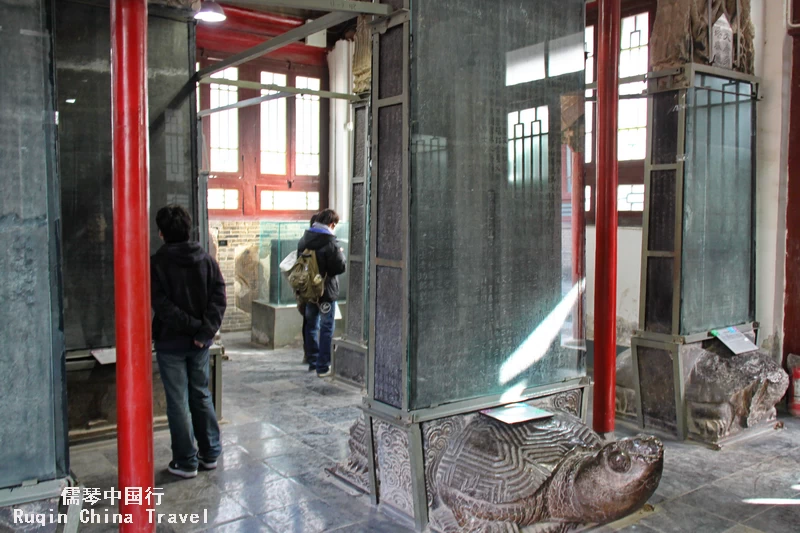
Additionally, the room features notable calligraphy masterpieces. For example, Yu Shinan’s “Stele of the Temple of Confucius” displays his elegant writing. Further, Monk Huairen’s compilation of Wang Xizhi’s calligraphy in the “Preface to the Sacred Teaching of the Tripitaka” is a must-see. Finally, Yan Zhenqing’s works, including the “Stele of the Many Treasures Pagoda” and the “Yan Family Temple Stele”, serve as iconic models that calligraphy enthusiasts have studied throughout history. These pieces offer a deep appreciation for Tang-era calligraphy.
3) Third Exhibition Room
The Third Exhibition Room displays famous steles featuring various calligraphic styles from the Han to the Song Dynasties. Notable examples of Seal Script include the Tang Dynasty’s “Inscription of the Poem on Shenquan in Meiyuan”. Clerical Script is represented by the Han Dynasty’s “Cao Quan Stele”.

Regular Script includes the Tang Dynasty’s “Stele of Zang Huaike”, and Running Script features the Tang Dynasty’s “Stele of Monk Huijian”. For Cursive Script, the Sui Dynasty’s “Thousand Character Classic by Zhi Yong” stands out. All of these are renowned masterpieces of Chinese calligraphy, admired both domestically and internationally.
4) Fourth Exhibition Room
The Fourth Exhibition Room features calligraphy works by renowned calligraphers from the Song to Qing Dynasties, including Su Shi, Huang Tingjian, Mi Fu, and Zhao Mengfu. These steles display their poems and writings, offering valuable insights into their literary and artistic styles. Additionally, steles from the Ming and Qing Dynasties provide precious historical records.
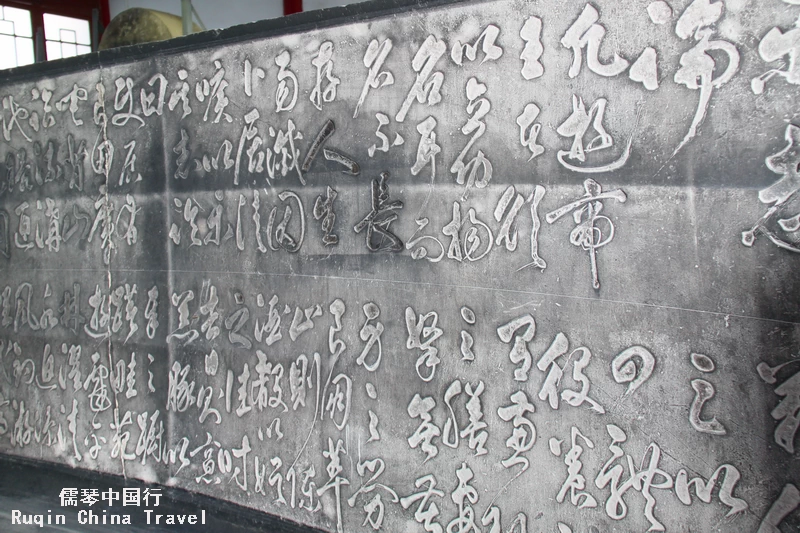
Furthermore, the room showcases line engravings from the Song to Qing Dynasties. Notable pieces include the Song Dynasty’s “Ruins of the Tang Taiji Palace” and the “Map of Xingqing Palace”. There are also Qing engravings like the “Complete Map of Mount Hua” and the “Eight Views of Guanzhong”. These works offer reference points for studying ancient architecture and historical sites.
5) Fifth Exhibition Room
The Fifth Exhibition Room displays historical steles from the Song, Yuan, Ming, and Qing Dynasties, with the majority from the Qing Dynasty. These steles provide valuable local historical records.
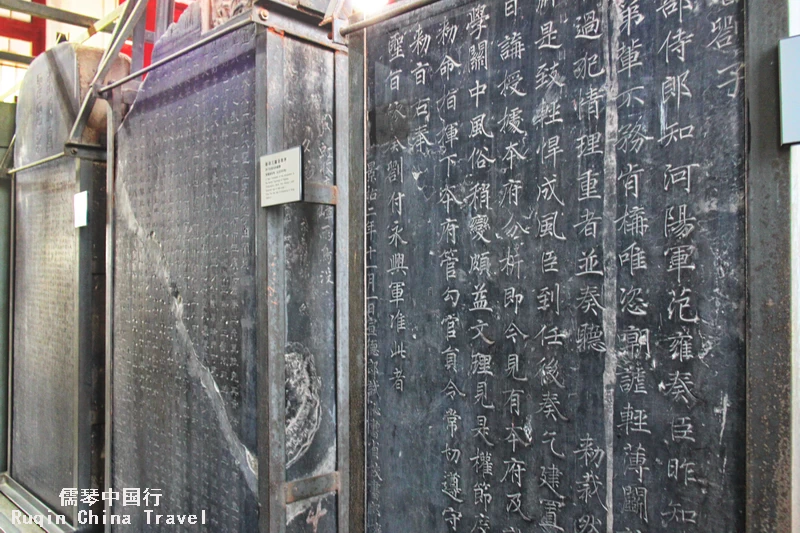
Additionally, many steles describe temple restorations, commendations, land allocation, education funding, and canal repairs. These inscriptions offer crucial insights into the society and local history of the time. Furthermore, they hold significant value for studying calligraphy, as the inscriptions showcase various artistic styles from different periods.
6) Sixth Exhibition Room
The Sixth Exhibition Room primarily displays steles featuring poetry and essays from the Qing Dynasty, although there are a few works from the Yuan and Ming Dynasties.
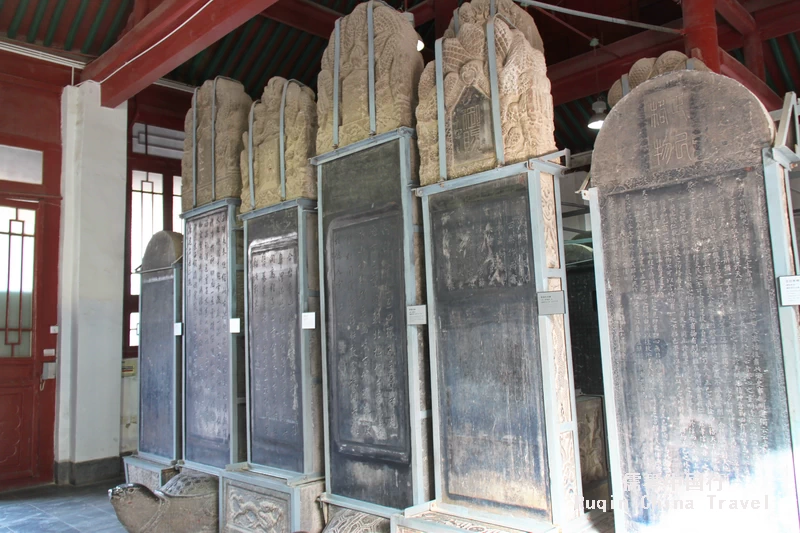
Notably, steles inscribed by Zhao Mengfu from the Yuan Dynasty, Dong Qichang from the Ming Dynasty, as well as those written by Emperor Kangxi and Lin Zexu from the Qing Dynasty, are among the rare treasures. Additionally, these works hold significant artistic value, showcasing the calligraphic excellence of their respective periods.
7) Seventh Exhibition Room
The Seventh Exhibition Room features 145 steles, which were re-carved during the Qing Dynasty from the “Chunhua Ge Tie” collection. These steles are carved on both sides, displaying various styles of calligraphy by ancient emperors, famous ministers, and renowned calligraphers. Additionally, you’ll find remarkable cursive script works from Wang Xizhi and Wang Xianzhi.
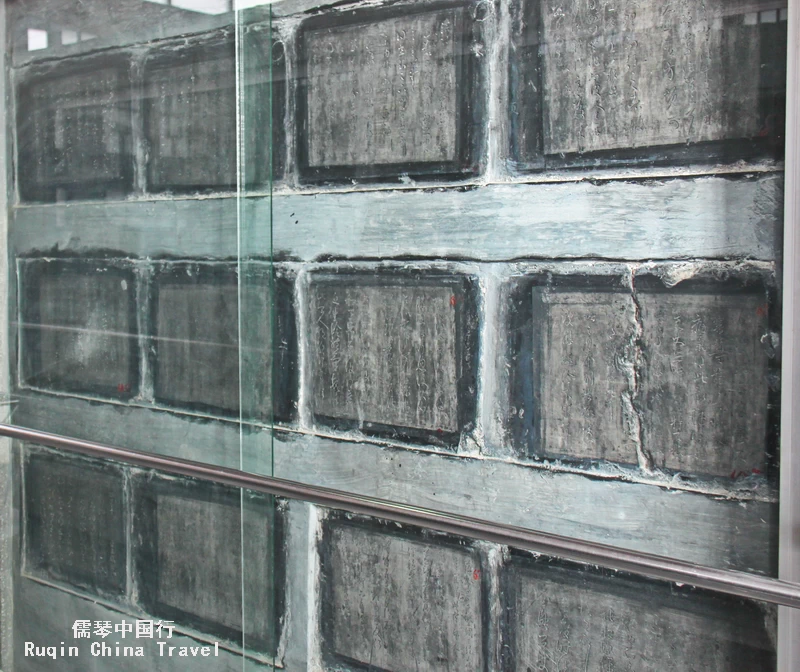
Moreover, these steles are considered rare and valuable examples of classic calligraphy, offering a unique glimpse into the artistic traditions of various historical periods.
8) The Horse Hitching Stakes
The horse hitching stakes in the Xi’an Stone Stele Museum are unique stone pillars used during the Tang and Song Dynasties for tying horses. These beautifully crafted stakes, often adorned with intricate carvings of mythical creatures such as lions, tigers, and dragons, were once a common sight in the city.
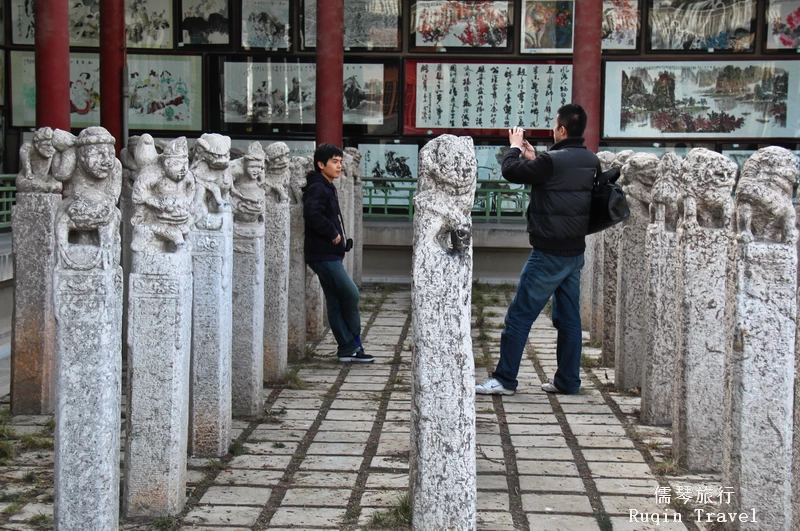
They reflect the artistic and practical aspects of daily life in ancient Xi’an. Visitors to the museum can explore these stone stakes as a symbol of the city’s vibrant history and the elegance of its past craftsmanship.
Services and Facilities at Xi’an Stone Stele Museum
Guided Tour Services: The stele museum provides well-trained guides who offer both Chinese and English tours, as well as on-demand services for specific exhibits.
Visitor Service Center: Located in a semi-open area near the entrance, the Visitor Service Center offers amenities such as hot water, televisions, wheelchairs, strollers, umbrellas, and chargers. The center is managed by dedicated staff, ensuring a comfortable and convenient experience for all visitors.
Accessibility: The museum features accessible pathways for people with disabilities, ensuring barrier-free access to all exhibition areas.
Exhibition Room Visitor Experience Area: The new Stone Carving Art Hall includes a multimedia interactive zone, allowing visitors to engage with the museum’s collections and experience traditional culture through interactive activities.
Top Attractions Near Beilin Museum Xi’an
After you finish exploring the Xi’an Stone Stele Museum, there are several nearby attractions worth visiting:
- Xi’an City Wall: A short walk from the museum, the Xi’an City Wall is the largest and best-preserved ancient city wall in China. Visitors can walk or bike along the top of the wall for stunning views of the city.
- Bell Tower and Drum Tower: These iconic landmarks are located within close proximity and offer an additional look at Xi’an’s rich history.
- Muslim Quarter: Famous for its vibrant street food, the Muslim Quarter is a must-visit for anyone looking to taste authentic local cuisine.
The Xi’an Stone Stele Museum is an essential stop for anyone interested in Chinese history, calligraphy, and art. Now that you know how to visit Xi’an Stone Stele Museum, you can fully immerse yourself in the world of ancient Chinese steles, sculptures, and inscriptions. The Xi’an Beilin Museum offers a fascinating journey through China’s artistic and literary heritage.
More Xi’an Travel Guides
Planning your Xi’an Tour? Our ” Xi’an Travel Guide” section offers essential advice to help you navigate the city like a pro. From transportation tips and local customs to insider recommendations for hidden gems, these travel tips will ensure you have a smooth, enjoyable, and unforgettable experience in China’s vibrant capital. Let us guide you through the best practices for exploring Xi’an with confidence!

